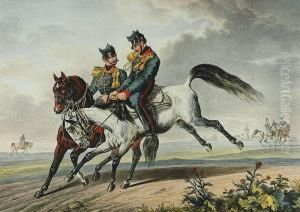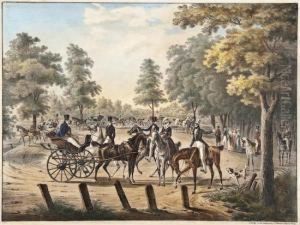Joseph Trentsensky Paintings
Joseph Trentsensky was an Austrian artist, engraver, and publisher, born in 1795 in Vienna, Austria. His career spanned a period of significant political and social transformation in Europe, which deeply influenced his work and the subjects he chose to depict. Trentsensky is often remembered for his contributions to the world of lithography, a printing technique that was gaining popularity in the early 19th century for its ability to produce high-quality images in relatively large quantities.
Initially trained as an engraver, Trentsensky expanded his artistic repertoire to include lithography, a skill he mastered and subsequently used to capture the essence of Viennese society, its people, and their customs. His works serve as valuable historical documents, providing insight into the everyday life and cultural norms of the time. Trentsensky exhibited a keen eye for detail and a playful sense of humor, often incorporating caricature and satire into his depictions of contemporary events and figures.
Beyond his artistic endeavors, Joseph Trentsensky was also an astute businessman. He owned a publishing house in Vienna, where he produced and sold a variety of printed materials, including books, pamphlets, and sheets of music, alongside his artistic prints. His establishment became a gathering place for intellectuals, artists, and musicians, further cementing his status as a key figure in the cultural life of Vienna.
Trentsensky's work did not go unnoticed during his lifetime. He was well-regarded by both the public and his peers, contributing significantly to the visual culture of the Biedermeier period, an era that emphasized simplicity, elegance, and a return to traditional values in the aftermath of the Napoleonic Wars.
Joseph Trentsensky passed away in 1852, leaving behind a rich legacy of artistic and cultural contributions. His prints and publications continue to be studied by historians and art enthusiasts alike, offering a window into the world of 19th-century Vienna. Trentsensky's ability to blend artistic skill with social commentary ensures his place in the annals of European art history.

